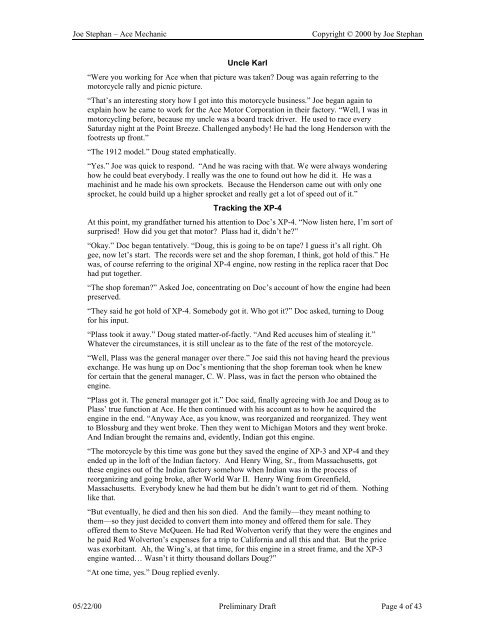From 1920 through 1924, Ace motorcycles were built in a ... - WebRing
From 1920 through 1924, Ace motorcycles were built in a ... - WebRing
From 1920 through 1924, Ace motorcycles were built in a ... - WebRing
You also want an ePaper? Increase the reach of your titles
YUMPU automatically turns print PDFs into web optimized ePapers that Google loves.
Joe Stephan – <strong>Ace</strong> Mechanic Copyright © 2000 by Joe Stephan<br />
Uncle Karl<br />
“Were you work<strong>in</strong>g for <strong>Ace</strong> when that picture was taken? Doug was aga<strong>in</strong> referr<strong>in</strong>g to the<br />
motorcycle rally and picnic picture.<br />
“That’s an <strong>in</strong>terest<strong>in</strong>g story how I got <strong>in</strong>to this motorcycle bus<strong>in</strong>ess.” Joe began aga<strong>in</strong> to<br />
expla<strong>in</strong> how he came to work for the <strong>Ace</strong> Motor Corporation <strong>in</strong> their factory. “Well, I was <strong>in</strong><br />
motorcycl<strong>in</strong>g before, because my uncle was a board track driver. He used to race every<br />
Saturday night at the Po<strong>in</strong>t Breeze. Challenged anybody! He had the long Henderson with the<br />
footrests up front.”<br />
“The 1912 model.” Doug stated emphatically.<br />
“Yes.” Joe was quick to respond. “And he was rac<strong>in</strong>g with that. We <strong>were</strong> always wonder<strong>in</strong>g<br />
how he could beat everybody. I really was the one to found out how he did it. He was a<br />
mach<strong>in</strong>ist and he made his own sprockets. Because the Henderson came out with only one<br />
sprocket, he could build up a higher sprocket and really get a lot of speed out of it.”<br />
Track<strong>in</strong>g the XP-4<br />
At this po<strong>in</strong>t, my grandfather turned his attention to Doc’s XP-4. “Now listen here, I’m sort of<br />
surprised! How did you get that motor? Plass had it, didn’t he?”<br />
“Okay.” Doc began tentatively. “Doug, this is go<strong>in</strong>g to be on tape? I guess it’s all right. Oh<br />
gee, now let’s start. The records <strong>were</strong> set and the shop foreman, I th<strong>in</strong>k, got hold of this.” He<br />
was, of course referr<strong>in</strong>g to the orig<strong>in</strong>al XP-4 eng<strong>in</strong>e, now rest<strong>in</strong>g <strong>in</strong> the replica racer that Doc<br />
had put together.<br />
“The shop foreman?” Asked Joe, concentrat<strong>in</strong>g on Doc’s account of how the eng<strong>in</strong>e had been<br />
preserved.<br />
“They said he got hold of XP-4. Somebody got it. Who got it?” Doc asked, turn<strong>in</strong>g to Doug<br />
for his <strong>in</strong>put.<br />
“Plass took it away.” Doug stated matter-of-factly. “And Red accuses him of steal<strong>in</strong>g it.”<br />
Whatever the circumstances, it is still unclear as to the fate of the rest of the motorcycle.<br />
“Well, Plass was the general manager over there.” Joe said this not hav<strong>in</strong>g heard the previous<br />
exchange. He was hung up on Doc’s mention<strong>in</strong>g that the shop foreman took when he knew<br />
for certa<strong>in</strong> that the general manager, C. W. Plass, was <strong>in</strong> fact the person who obta<strong>in</strong>ed the<br />
eng<strong>in</strong>e.<br />
“Plass got it. The general manager got it.” Doc said, f<strong>in</strong>ally agree<strong>in</strong>g with Joe and Doug as to<br />
Plass’ true function at <strong>Ace</strong>. He then cont<strong>in</strong>ued with his account as to how he acquired the<br />
eng<strong>in</strong>e <strong>in</strong> the end. “Anyway <strong>Ace</strong>, as you know, was reorganized and reorganized. They went<br />
to Blossburg and they went broke. Then they went to Michigan Motors and they went broke.<br />
And Indian brought the rema<strong>in</strong>s and, evidently, Indian got this eng<strong>in</strong>e.<br />
“The motorcycle by this time was gone but they saved the eng<strong>in</strong>e of XP-3 and XP-4 and they<br />
ended up <strong>in</strong> the loft of the Indian factory. And Henry W<strong>in</strong>g, Sr., from Massachusetts, got<br />
these eng<strong>in</strong>es out of the Indian factory somehow when Indian was <strong>in</strong> the process of<br />
reorganiz<strong>in</strong>g and go<strong>in</strong>g broke, after World War II. Henry W<strong>in</strong>g from Greenfield,<br />
Massachusetts. Everybody knew he had them but he didn’t want to get rid of them. Noth<strong>in</strong>g<br />
like that.<br />
“But eventually, he died and then his son died. And the family—they meant noth<strong>in</strong>g to<br />
them—so they just decided to convert them <strong>in</strong>to money and offered them for sale. They<br />
offered them to Steve McQueen. He had Red Wolverton verify that they <strong>were</strong> the eng<strong>in</strong>es and<br />
he paid Red Wolverton’s expenses for a trip to California and all this and that. But the price<br />
was exorbitant. Ah, the W<strong>in</strong>g’s, at that time, for this eng<strong>in</strong>e <strong>in</strong> a street frame, and the XP-3<br />
eng<strong>in</strong>e wanted… Wasn’t it thirty thousand dollars Doug?”<br />
“At one time, yes.” Doug replied evenly.<br />
05/22/00 Prelim<strong>in</strong>ary Draft Page 4 of 43

















